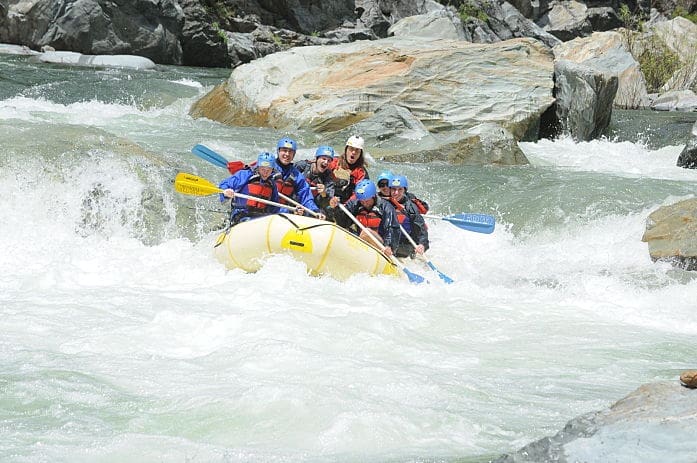
High in the Sierra Nevada mountains, the headwaters of the North Fork American River trace their origin near the backdrops of renowned Sugar Bowl and Palisades Tahoe ski resorts. Spring, from April to June, brings optimal boating conditions as the river flow is intricately linked to the Sierra snowpack. This season also unveils a breathtaking display of wildflowers in full bloom, casting vibrant hues against the turquoise water and gray cliffs, creating a picturesque canyon landscape.
Preserving its pristine beauty, the North Fork American River was granted Wild and Scenic status in 1978. This protective designation shields the nearly untouched canyon from potential threats such as logging, damming, and development. In contrast to the Middle Fork, the North Fork bears fewer visible remnants of the Gold Rush era. Despite a modest population of around 2000 inhabitants at the Green Valley Miner Camp in 1851, the challenging canyon terrain and transportation difficulties led most miners to seek fortune in other rivers, leaving the North Fork relatively untouched by the bustling activity of the 1850s.
As you venture through the canyon, you’ll encounter a rich tapestry of flora, with Oaks, Alders, and Pines providing shelter for a diverse array of wildlife. The area is home to various species, including Black Bears at higher elevations, mountain lions, spotted owls, peregrine falcons, golden eagles, and deer. The presence of these inhabitants adds to the enchanting allure of the natural surroundings.
Majestic mule deer graze in tranquil meadows, while the iconic black bear roams through wooded expanses. The elusive mountain lion, a symbol of the wild, further enhances the allure of this rich and varied landscape. In the delicate balance of nature, the upper American River watershed serves as a refuge for endangered species. The American bald eagle soars gracefully through the skies, embodying the spirit of freedom and resilience. The California red-legged frog, with its distinctive markings, finds sanctuary in the waters, contributing to the intricate web of life. The valley elderberry longhorn beetle, an emblem of ecological diversity, adds another layer of uniqueness to this vital ecosystem.
The North Fork American River is located in the Sierra Nevada foothills flowing from the western Tahoe to Folsom Lake. This wild n scenic river flows thru Colfax, Weimar and Auburn with many rafting and kayaking runs for private and commercial boaters.
The North Fork American River starts from Mountain Meadow Lake on the peak of Granite Chief in Tahoe National Forest. The river flows freely down to Lake Clementine in the Auburn State Recreation Area.
The North Fork American River features Class 4-4+ rapids, offering an exhilarating and challenging rafting experience.
Where is the North Fork American River located?
Located in the Gold Country foothills, the North Fork American River flows near Colfax, California.
The river originates in the Tahoe National Forest and travels through the scenic canyons before joining the main stem of the American River.
Adventure seekers can enjoy white water rafting, navigating through thrilling rapids like ‘Chamberlain Falls’ and ‘Devil’s Staircase,’ surrounded by stunning natural scenery.
The typical North Fork American River rafting trip varies in duration, but commonly spans a full day of exciting white water adventure.
What makes the North Fork American River unique is its challenging Class 4-4+ rapids, including the iconic ‘Chamberlain Falls,’ providing an adrenaline-pumping experience for rafters amid the picturesque wilderness of the Gold Country.
We would like to acknowledge the Southern Maidu people to the North, the Valley and Plains Miwok/ Me-Wuk Peoples to the south of the American River, and the Patwin Wintun Peoples to the west of the Sacramento River.
Acknowledging the Indigenous communities whose lands we visit is a crucial step in understanding our shared history and the ongoing challenges faced by these populations today. For more insight, visit our Territory Acknowledgement page. We encourage you to learn about the people whose land we’re privileged to explore by following the links above. Our Territory Acknowledgement is an evolving project. If you find missing information or acknowledgments, please share it with us. Together, we can ensure accuracy, inclusivity, and respect. Thank you.